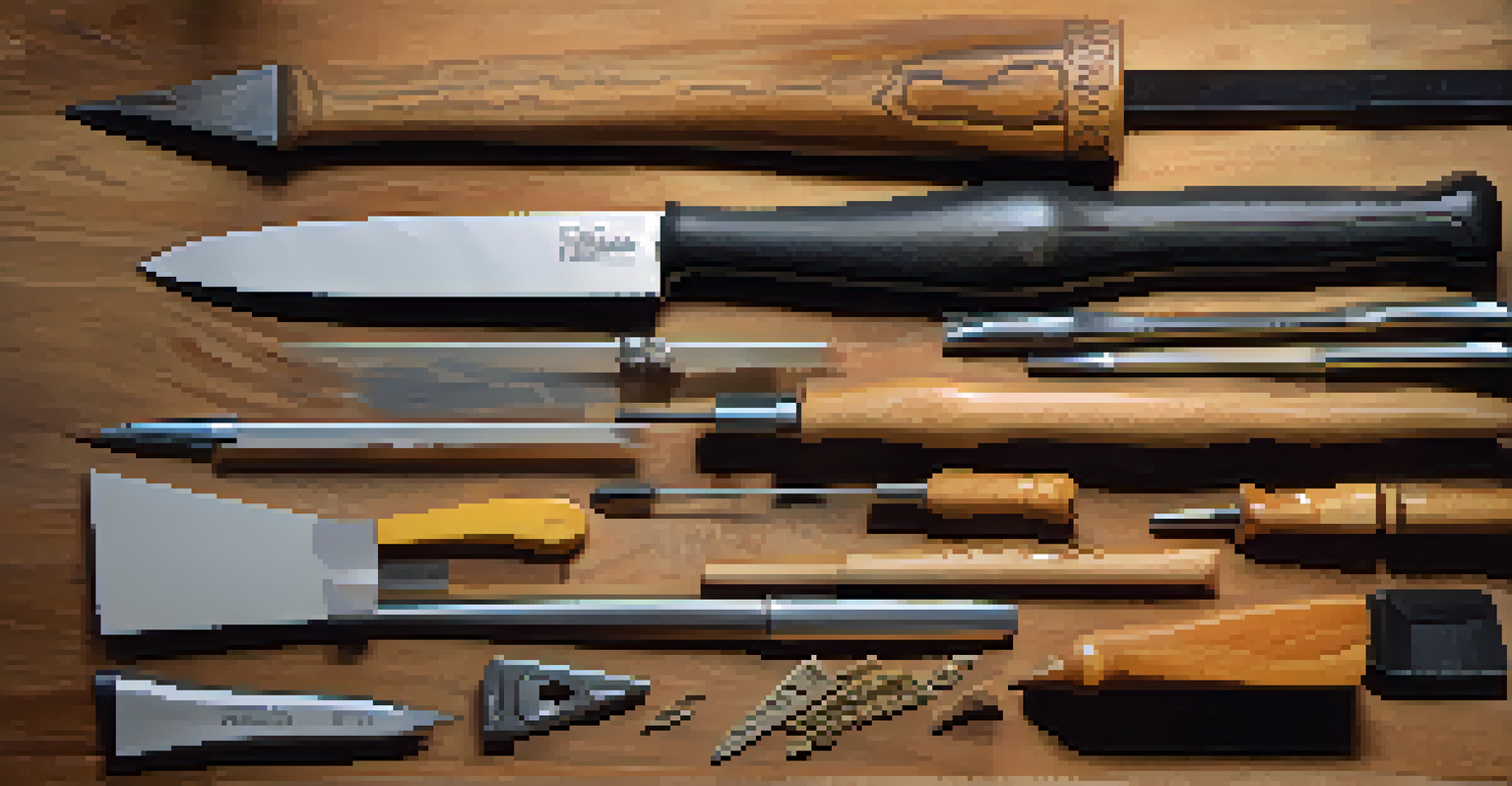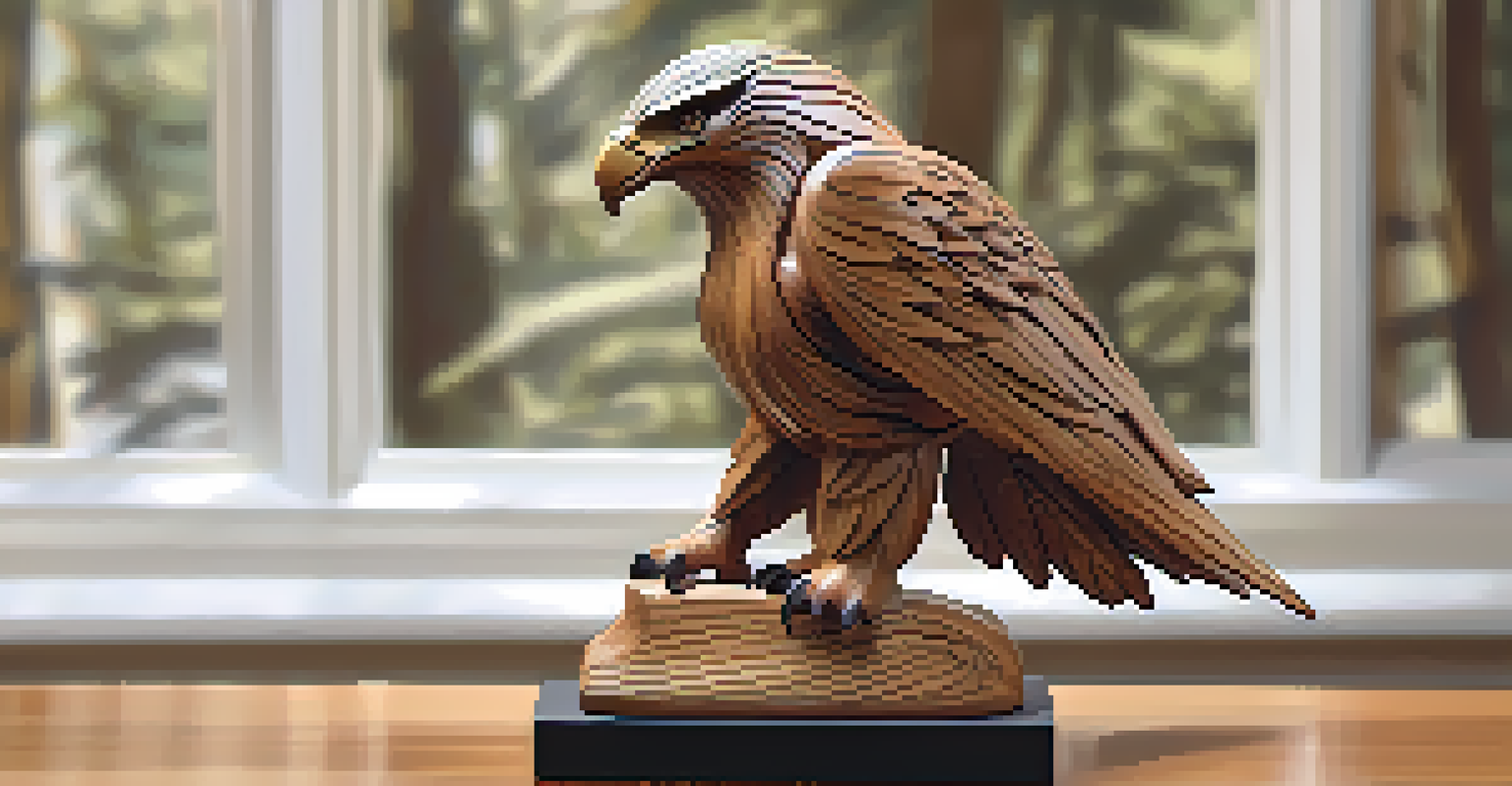Advanced Carving Techniques: Tools for Experts

Understanding Advanced Carving Techniques for Experts
Advanced carving techniques go beyond the basics, allowing artisans to create intricate designs and textures. Mastering these techniques requires not just skill but also an understanding of various tools and materials. Expert carvers often employ methods like relief carving, chip carving, and power carving to achieve stunning results.
The more I work, the more I realize how much I need to learn.
For instance, relief carving involves creating a raised design on a flat surface, which can add depth and dimension to your projects. Chip carving, on the other hand, focuses on removing small chips from the wood to form patterns and motifs. Each technique demands precision, patience, and a keen eye for detail.
As you delve into these advanced methods, you'll discover that they not only enhance your craftsmanship but also allow for personal expression. Whether it's through the delicate lines of relief work or the bold patterns of chip carving, these techniques can transform your wooden pieces into true works of art.
Essential Tools for Advanced Carving Techniques
Equipping yourself with the right tools is crucial for mastering advanced carving techniques. While traditional tools like chisels and gouges are fundamental, experts often rely on specialized tools to achieve precise results. A well-rounded toolkit can include everything from knives to rotary tools, each serving a unique purpose in the carving process.

For example, a set of high-quality carving knives allows for intricate detailing, while rotary tools can speed up the process for larger projects. Additionally, specialized chisels such as V-tools and U-gouges enable carvers to create varied textures and lines, elevating the overall design. Investing in these tools can make a significant difference in your work.
Master Advanced Carving Techniques
Expert carvers utilize techniques like relief and chip carving to create intricate designs and showcase their craftsmanship.
Moreover, understanding how to properly maintain and sharpen your tools is vital for achieving the best results. Dull tools can lead to frustration and uneven cuts, ultimately impacting the quality of your work. Regular maintenance not only extends the life of your tools but also enhances your carving experience.
Choosing the Right Wood for Carving Projects
The type of wood you choose can significantly affect the outcome of your carving projects. Hardwoods like oak and maple are popular for their durability and beautiful grain patterns. However, softer woods like pine and basswood are often preferred by beginners because they are easier to carve and less likely to dull your tools.
Art is not freedom from discipline, but disciplined freedom.
As you advance in your skills, you may want to explore different wood species to achieve specific effects. For instance, cherry wood offers a rich color that deepens over time, while walnut provides a dark, luxurious finish. Each type of wood has its own unique characteristics that can enhance the overall aesthetic of your work.
Additionally, consider the moisture content of the wood before starting any project. Wood that is too dry or too wet can warp during the carving process, leading to unsatisfactory results. Understanding the properties of your chosen wood will help you make informed decisions that contribute to a successful carving experience.
Techniques for Achieving Intricate Designs
Creating intricate designs requires a combination of skill, patience, and strategic planning. One effective technique is to sketch your design on paper before transferring it to the wood. This allows you to visualize the final product and make any necessary adjustments before you start carving.
Another technique is to work in layers, gradually removing material to reveal the desired design. This method not only helps maintain control but also allows for more detailed work on features like facial expressions or fine patterns. By taking your time and focusing on one section at a time, you can ensure precision in every cut.
Essential Tools for Carving Success
A well-rounded toolkit, including specialized chisels and rotary tools, is crucial for achieving precise results in advanced carving projects.
Finally, don't underestimate the power of practice. The more you carve, the more comfortable you'll become with your tools and techniques. Engaging in smaller projects can build your confidence and sharpen your skills, eventually leading to more complex designs.
Incorporating Textures into Your Carving Projects
Texture adds depth and interest to carved pieces, transforming a flat surface into a tactile experience. Carvers can use various techniques to create texture, such as stippling, feathering, and sanding. Each technique can evoke different feelings and responses from viewers, enhancing the overall impact of your work.
For example, stippling involves creating a series of small dots to form a pattern, while feathering uses fine cuts to produce soft, feathery effects. These textures can help to emphasize certain areas of your design or create a sense of movement within the piece. Experimenting with different textures allows you to develop your unique style.
Additionally, combining different textures can lead to stunning contrasts that capture attention. By layering smooth and rough surfaces, or mixing detailed designs with broader strokes, you can create a more dynamic composition. This approach not only showcases your technical skills but also invites viewers to appreciate the intricacies of your art.
Safety Tips for Advanced Carving Projects
Safety should always be a top priority when engaging in advanced carving projects. Using sharp tools can be intimidating, but with the right precautions, you can minimize the risk of injury. Always wear protective gear, such as gloves and safety glasses, to shield yourself from potential accidents.
Creating a designated, clutter-free workspace is also essential for maintaining safety. Ensure that your tools are organized and easily accessible, reducing the likelihood of mishaps caused by searching for misplaced items. A well-lit area will help you see your work clearly, further enhancing your focus and precision.
Importance of Wood Selection
The choice of wood significantly impacts your carving results, with different species offering unique characteristics and effects.
Lastly, never rush the carving process. Taking your time allows you to maintain control and make deliberate cuts, decreasing the chances of accidents. Remember, a moment of carelessness can lead to unnecessary injuries or damage to your work, so stay mindful and enjoy the creative journey.
Finishing Techniques for Carved Projects
Once your carving is complete, the finishing touches can elevate your project to a new level. Finishing techniques, such as sanding, staining, and sealing, enhance the wood's natural beauty while protecting it from wear and tear. Each step in the finishing process is crucial for achieving a polished and professional look.
Sanding is essential for smoothing out any rough edges and preparing the surface for further treatment. Choose sandpaper with varying grits to achieve a fine finish, gradually working your way up to a smoother texture. After sanding, applying a stain can bring out the wood's grain and add a splash of color to your piece.

Finally, sealing your project with a protective coat will safeguard it from moisture and environmental factors. This step is particularly important for items that will be displayed outdoors or used regularly. By investing time in the finishing process, you'll ensure that your carved pieces remain beautiful and durable for years to come.